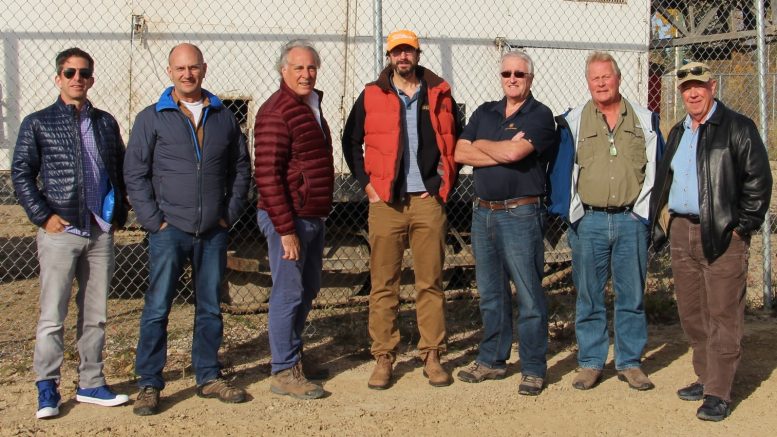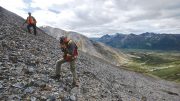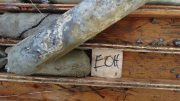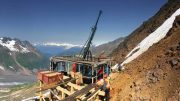Osisko Metals (TSXV: OM) is expanding its zinc footprint to northern Canada in a $35-million deal to acquire Pine Point Mining (TSXV: ZINC) and its Pine Point project near Hay River in the Northwest Territories.
Pine Point — once Canada’s most profitable zinc-lead mine — produced nearly 64 million tonnes of ore from 52 deposits between 1964 and 1987. Another 46 deposits on the property were found but never put into production.
The acquisition, combined with Osisko Metals’ 500 sq. km of zinc properties in New Brunswick’s Bathurst mining camp, gives the junior exploration and development company control over two world-class, past-producing base metal camps.
“For 50 years Brunswick was the largest underground zinc mine in the world and Pine Point was the most profitable open-pit operation at that time in Canada,” Osisko Metals president and CEO Jeff Hussey says. “These are the two premiere zinc-producing mining camps, and we are going to work hard to create value in both camps.”
Pine Point Mining completed a preliminary economic assessment of the project, 10 km south of Great Slave Lake and 65 km east of Hay River, in May 2017, outlining a 13-year mine life with total life-of-mine production of 1.35 billion lb. zinc and 536 million lb. lead.

Historic pits at the Pine Point lead-zinc property in the N.W.T. Credit: Darnley Bay.
The PEA envisioned a mining plan in which 10 open-pit deposits (a restricted subset of the known open-pit deposits on the property) would be developed and mined in sequence using dense media separation plants and traditional grinding and flotation to upgrade the mineralized material into lead and zinc concentrates. The after-tax net present value was $210.5 million, with a 34.5% internal rate of return using US$1.10 per lb. zinc and US$1 per lb. lead.
The study was based on an indicated resource of 25.8 million tonnes grading 2.9% zinc and 1.1% lead, and another 3.7 million tonnes of inferred resources averaging 2.9% zinc and 1.1% lead.
Osisko Metals can grow the resource by converting historic resources and finding more mineralization on the property. The known deposits at Pine Point extend over a 65 km strike length.
“There are an additional 50 million tonnes in historical resources hosted in roughly 36 deposits that were left undeveloped from the Cominco days, so that creates great upside for the project to increase the resource base,” Hussey says in an interview. “That’s the value creation proposal in front of us.”
The mining executive, who spent 20 years working for Noranda, including a stint at the Brunswick No. 12 zinc mine in the Bathurst camp, says Osisko Metals wants to take advantage of the winter exploration season this year and is contemplating a 5,000- to 10,000-metre drill program once the transaction is completed. The program would call for definition drilling, but the company will review priority exploration targets, too.
The project benefits from good metallurgy, excellent infrastructure and a skilled pool of labour in Hay River, Hussey notes.

Drill core in 2016 from the historic lead-zinc Pine Point operation in the Northwest Territories. Credit: Darnley Bay Resources.
Prior metallurgical testing suggests high concentrate grades, up to 59.5% zinc and 76.7% lead, with negligible deleterious elements.
“The metallurgy at Pine Point is exceptional and tests to date indicate a clean concentrate product, as was the case with the historical production,” Hussey says. “In the early days, they were able to produce direct shipping ore for the Trail smelter in southern British Columbia.”
The rail head at Hay River is 65 km from the Pine Point property, with the rail line extending to Edmonton.
There was also another rail connection to the former mine site. The rails were removed but the rail bed is still there.
In addition, there is an electrical substation with enough capacity in the heart of the mining camp and paved roads run throughout the project, including over 100 km of haul roads that are still in good condition.
Osisko Metals’ largest shareholders are Osisko Gold Royalties (TSX: OR; NYSE: OR) and Osisko Mining (TSX: OSK; US-OTC: OBNNF), which together own 20% of the company.
Since its start in June 2017, Osisko Metals has had a market capitalization ranging between $60 and $100 million.
“A large part of that value is due to the confidence in the Osisko brand,” Hussey says, noting that as a group, the Osisko team has created $9 billion in shareholder value over its 13-year history.
Jamie Levy, Pine Point Mining’s president and CEO, notes that Osisko Metals and the support of the Osisko group offers “exceptional technical depth and access to capital.”
“It makes so much sense for us to collaborate with these guys because of their background,” he tells The Northern Miner. “Osisko Metals can take this project to the next level.”

Infrastructure map of the Pine Point property package 42 km due east of Hay River, Northwest Territories. Credit: Darnley Bay.
With $38 million in the bank and the benefit of the Osisko group’s technical team, Hussey says, Osisko Metals is cashed up and ready to “aggressively pursue exploration and development to create value.”
Under the proposed deal, shareholders of Pine Point will receive 0.271 of an Osisko shares and 0.0677 of a warrant. Each whole warrant can be exercised in to a share at $1.50 for 12 months.
Pine Point shareholders will also receive one share of a newly formed company that will hold all of the assets and liabilities of Pine Point, excluding the Pine Point project. The shares of this new company will be consolidated on a 10-to-1 basis.
If the deal is completed, existing shareholders of Osisko Metals and Pine Point will own 62% and 38% of Osisko Metals on a pro-forma, fully diluted, in-the-money basis.
The exchange ratios in the proposed transaction represent a 23% premium based on the closing share prices of each company as of Dec. 15, 2017 — the day the proposed acquisition was announced — and a 27% premium based on the 30-day, volume-weighted average prices of each company. On a fully diluted, in-the-money basis, the transaction implies a total equity value of $35 million.
“That’s just the value of the Pine Point project to our shareholders, however — the bigger value would be the two companies together,” Pine Point CEO Levy says. “Bathurst and Pine Point are two of the most prolific base metal mining camps in Canadian history, so to combine these two camps together into one company with the Osisko group’s reputation, that’s very important to me, and to many other people right now.”

A drill rig at the Pine Point zinc project. Credit: Osisko Metals.
Hussey says that advancing zinc projects “during a period of exceptional supply and demand fundamentals for zinc, when the price is ranging between US$1.40 and US$1.50, with forecasts that it will go higher until 2020,” adds appeal to the business combination.
“It’s a whole new day for these mining camps with the new supply and demand fundamentals, and the higher price range for zinc. We want to re-enter these camps and develop an economic resource base as quickly as possible.”
Over the last year, Osisko Metals has picked up over 500 sq. km in the Bathurst camp, the third-largest volcanogenic massive sulphide camp in the world. Its assets there include the Brunswick belt project, which covers parts of the strike length that hosted both the Brunswick No. 12 and No. 6 mines to the east.
Brunswick No. 12 was the world’s largest underground zinc mine and produced 137 million tonnes of ore grading 8.74% zinc, 3.44% lead, 0.37% copper and 102 grams silver per tonne over its 49-year mine life, which ended in 2013. The Brunswick No. 6 mine, a pit just south of Brunswick No. 12, developed 13 million tonnes at similar grades.






Be the first to comment on "Osisko Metals to acquire Pine Point zinc mine in NWT"